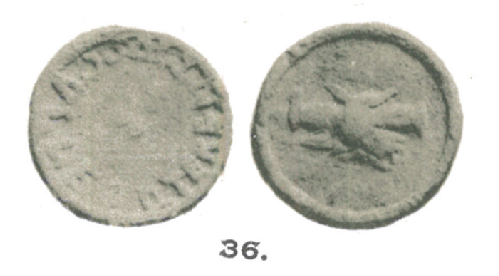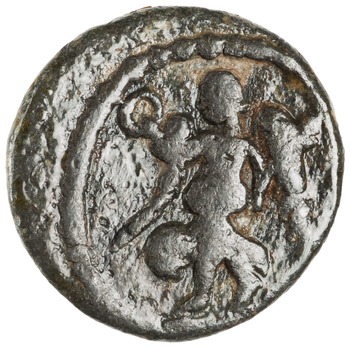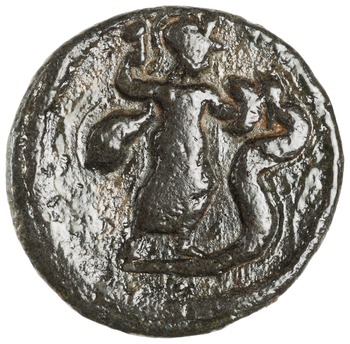All 2 entries tagged Alternative Currencies
No other Warwick Blogs use the tag Alternative Currencies on entries | View entries tagged Alternative Currencies at Technorati | There are no images tagged Alternative Currencies on this blog
May 16, 2016
Tokens from the Tiber: Alternatives Currencies?
During construction works in Rome in the eighteenth and nineteenth centuries, an enormous variety of objects came to light. Amongst the items was a collection of lead money-like objects, initially published by Ficorini in 1740, who labelled the objects tesserae, a word he found in ancient literary texts and which he thought described these objects and their function. Virlouvet has convincingly demonstrated, however, that these money-like objects are not the tessera frumentaria of ancient Latin texts. What then are they?
 |
 |
Two tokens from the Tiber assemblage: one carries images of a priestly staff (lituus) and an altar, the other the name of Q. Terentius Culleo and clasped hands.
The connection with tessera frumentaria was perhaps created because some of these objects carry the image of a modius with corn-ears; the idea then that these objects were used in corn distirbutions in Rome was an easy conclusion. But when one examines the assemblage from the banks of the Tiber more closely, this interpretation comes into serious question. Dressel published this assemblage, consisting of 487 lead tokens, at the beginning of the 20th century, and concluded that it may have been a hoard dated to around the middle of the first century AD. Examining the imagery of these tokens I was struck by the fact that many of the images chosen, including the modius, imitate or reference the design of Augustan and Julio-Claudian quadrantes, the smallest coin denomination at this time. Twenty-seven tokens carried a modius accompanied by the legend QAE and OPT (?) on either side (Rost. 383); these are 17mm in diameter, roughly the same size as a Roman quadrans.
 |
|
Quadrans of Augustus with clasped hands and moneyer's name.
© Trustees of the British Museum (R.6223)
|
From the same assemblage is a token (18mm) in the name of Q. Terentius Culleo showing clasped hands, a type also found on quadrantes under Augustus. Even the way Culleo's name is presented, around the outer edge of the token in a circle, imitates money of this period. Other tokens carry altars, a lituus, an eagle with open wings, and balanced scales. If you examine the iconography of quadrans from this period (available to view here), you'll find these same images. Given that these tokens came to light in the eighteenth century, its difficult to know for certain if this is a 'hoard'. But Dressel's conclusion, that this assemblage is likely to be the privately produced small change, is a good one given the similarities in imagery and size between these objects and officially produced quadrantes. Dressel believed the 'hoard' was the till of a merchant or innkeeper - the tokens found in highest quantity (carrying an altar on one side and lituus or priestly staff on the other, shown above, and which had 205 examples) were those of the owner; the other tokens were the differing currencies issued by other individuals in the region. It appears then, that in a localised area in Rome, small change may have been privately produced, and circulated alongside official currencies. Some of these tokens carried the imagery and titulature of Nero and Octavia. What does this mean for the imperial image? Its something I am going to work on in the future at an upcoming workshop in Durham.
While some tokens may have served as small change, others obviosuly had other purposes. Stay tuned for more revelations from the ERC-funded Token Communities in the Ancient Mediterranean Project!
Select Bibliography
Dressel, H. (1922). Römische Bleimarken. Zeitschrift für Numismatik 33: 178-183.
Ficoroni, F. (1740). I piombi antichi. Rome, Girolamo Mainardi.
Rostowzew, M. (1903). Tesserarum urbis romae et suburbi. St. Petersburg.
Virlouvet, C. (1995). Tessera Frumentaria. Les procédures de distribution du blé à Rome à la fin de la République et au débout de l'Empire. Rome, École française de Rome.
September 10, 2015
The bitcoin of antiquity? Community Currencies in Roman Egypt
The use of alternative or community currencies and payment systems is often commented upon in the modern day, whether it is the Bristol pound, Bitcoin, or Ithaca hours. Alternative currencies are also springing up in Greece in the face of its monetary crisis, and may form a way of allowing the domestic economy to continue in the face of austerity. Such currencies also probably existed in the Roman world, used when there was a shortage of official governmental currency or small change. Egypt, for example, has furnished thousands of lead tokens, often bearing the names of different cities (e.g. Memphis). These objects have similarities with the official currency of Egypt that was struck in Alexandria (carrying regnal years as dates, for example), and appear to have been used as local currency once the imperial mint ceased large-scale production in c. AD 220.
 |
|
Lead token of Egypt showing a male figure being crowned by Victory
and the Nile riding a hippopotamus, holding reeds and a cornucopia.
Dated to 'Year 3' of an uncertain era. (Dattari 6462, 19.5mm)
|
Particular tokens are found only in very small areas, often within a city and its hinterland, similar to the way that the Bristol pound, for example, is used only in Bristol. It appears then that these objects were used like the community currencies of the present day, facilitating local transactions and economies within a small area. Their use as money is further suggested by the recent publication of a shipwreck found off the Carmel Coast in Israel. The wreck dates from the 3rd century AD, and contained a hoard of 162 coins (including 68 denarii) including a significant quantity of provincial bronze coins (74 in total), and billon coins from Alexandria. Three Egyptian 'tesserae' or tokens were also in the hoard. The interpretation of the hoard is that it is the purse of a sailor, merchant or ship owner who carried a variety of currencies to save on exchange fees in different ports. The tokens, similar to that shown above (but with different designs) are interpreted as tokens for habour services. But, given that the find contexts of similar objects throughout Egypt show them alongside or in similar contexts to official currency, they should be seen as local currency, hoarded by the owner of the purse along with his other local coinage.
 |
 |
These objects shed light on the economic history of Egypt, as well as the self-representation of different groups within the province, similar to the way that the designs of provincial coinage reflect the identities and culture of local cities. That alternative or community currencies existed alongside the denarius system in the Roman Empire reveals how a universal currency used throughout Europe was historically supplemented by other payment systems.
Select Bibliography:
Meshorer, Y. (2010). Coin Hoard from a Third-Century CE Shipwreck off the Carmel Coast, Atiqot 63: 111-135.
Milne, J. G. (1908). The leaden token-coinage of Egypt under the Romans. Numismatic Chronicle 8: 287-310.
Images from Classical Numismatic Group Inc., Electronic Auction 353, lot 369 (www.cngcoins.com), and the American Numismatic Society, 1944.100.79822.
 Clare Rowan
Clare Rowan

 Please wait - comments are loading
Please wait - comments are loading

 Loading…
Loading…

